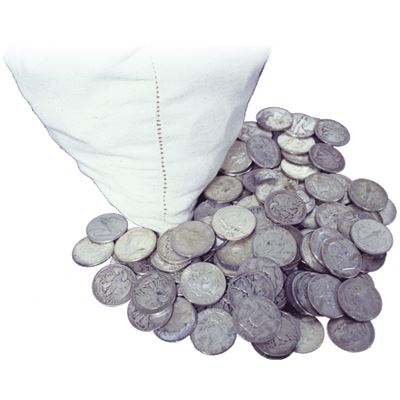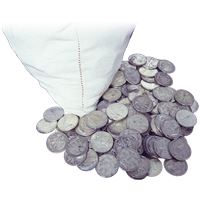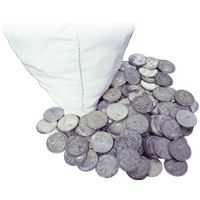"Only Halves" $1 Face Value of 90% Silver Coins (Mix of Kennedy, Walkers, Barbers, and Franklins)


| Qty | Check / Bank Wire | Credit Card |
|---|---|---|
| 1 - 99 | $26.43 | $27.35 |
| 100 - 249 | $26.18 | $27.09 |
| 250 - 499 | $25.93 | $26.84 |
| 500+ | $25.68 | $26.58 |
Product Highlight:
- 90% Silver Legal Tender US Half Dollars
- Each Bag Random
- Possible Coins Include:
- 1916-1947 Walking Liberty
- 1948-1963 Franklin
- 1964-only Kennedy
- 1892-1915 Barber Also Possible


Buy "Only Halves" $1 Face Value of 90% Silver Coins (Mix of Kennedy, Walkers, Barbers, and Franklins)
Many people prefer purchasing American 90% silver coins for investment over modern bullion. The pre-1965 half dollars offered here have a substantial, chunky feel that the old dimes and quarters lack. 90% silver half dollars also save you money when you’re shopping for formerly circulated silver. Two of these halves, equaling one dollar face value, saves you more than 25% compared to buying one greatly-worn, “cull” silver dollar.
The coins you receive in your 90% halves order can be from several iconic designs.
The Walking Liberty half dollar was minted from 1916 to 1947. It is one of the most beautiful coins ever produced by the US Mint. This beloved design was revived in 1986 for the American Silver Eagle, America’s first 1 oz .999 pure silver coin.
The Franklin half dollar was produced from 1948 to 1963, and has many fans in its own right. Featuring a large portrait of “the Renaissance Man of the American Revolution”, the Franklin half carried the colonial theme over to the reverse, which sported the Liberty Bell.
Another type of half dollar that could show up in your order is the 1964 Kennedy half. These 1964 mintage halves are the only Kennedys struck in 90% silver. Rising silver prices forced the US government to downgrade half dollars to 40% silver in 1965, and remove it completely in 1971
Rarely, your order of 90% silver halves may include a Barber half dollar, minted between 1892 and 1915. Designed by Chief Engraver Charles Barber, its 19th Century aesthetic found itself out of step with the great transformation in American coinage that began in 1907.
The Barber Half Dollar (1892 - 1915)
The Barber half dollar was minted every year from 1892 to 1915 in both Philadelphia and San Francisco, from 1892 to 1909 in New Orleans, and intermittently between 1906 and 1915 at Denver. The Barber design was also used for the dime and quarter introduced at the same time. These coins were officially named “Liberty Head”, but have been referred to as “Barbers” since their inception.
Prior to 1892, US silver coinage used the Seated Liberty design, introduced in the late 1830s. Many felt it was a ripoff of the seated Britannia on British coinage. Calls to change the design grew in the 1870s, but an unexpected inflow of old silver coins shelved those efforts.
The Great Silver Coin Flood of 1877
Early Union losses in the Civil War caused a panic in the North, resulting in gold and silver coins vanishing from circulation. Many people sent their hoarded silver to Canada or Latin America to prevent confiscation by a government desperate for cash.
In 1877, the price of silver finally fell enough for silver coins to circulate again. Millions of silver coins suddenly emerged from their foreign hiding places, choking Treasury vaults. It took a decade for the coin supply to fall to where new coins, and a new design, could be considered.
The Coin Contest Debacle of 1892
The Mint decided to hold a first-ever open contest for the new coin designs. The results were predictable. The nearly 300 participants ranged from professional sculptors to an inmate of an insane asylum, and included a surprising number of women. None of the submitted designs were suitable for coins. A separate appeal to ten famous sculptors failed because the Mint would only pay the winner.
Admitting defeat, Director of the Mint Edward Leech ordered Barber to proceed with his own designs, but to craft them in the “French style”. After some trial and error, a design was agreed upon, but showed little French influence.
Did You Know?
- Charles Barber didn’t even know how to engrave when he was hired by his father, Chief Engraver William Barber, to work at the Mint in 1869.
- Barber worked at the US Mint for 47 years, until his death in 1917. This is the second-longest service by any Mint engraver. George T. Morgan beat him by one year.
- Charles Barber was the longest-serving Chief Engraver, serving in that post for 38 years from the death of his father in 1879 to his own death in 1917.
- Dismissed as mediocre at best for his circulating coin designs, Barber broke out artistically with a series of lauded commemorative coins late in life.
The new dime, quarter, and half dollar shared the same obverse of a Liberty bust facing right. The dime’s reverse had the denomination in a wreath. The reverse for the quarter and half dollar housed a rustic heraldic eagle that some felt owed more to the first US coins minted in the 1790s than to any contemporary influence. Some felt that Barber’s Liberty Head resembled a (male) Greek youth more than a female.
The only thing everyone agreed on was that Barber knew how to make a design that worked properly on a high-speed coining press. As Barber’s later fights with commissioned artists, including Saint-Gaudens and Weinman, revealed, few outside sculptors understood the importance of low relief designs for mass-produced coins.
Barber half dollars were minted in 24 different years. There are 73 date and mint combinations, with one major variety (the 1892-O “micro O”). Total mintage was just under 136 million.
The Walking Liberty Half Dollar (1916 - 1947)
By 1915, the nation had six new coin designs from some of the most famous artists of their time. Augustus Saint-Gaudens’ gold eagle and double eagle; Bela Lyon Pratt’s intaglio gold half eagle and quarter eagle; Jame Earle Fraser’s Buffalo nickel; and Victor D Brenner’s Lincoln cent were all new and exciting designs. 1916 saw two more famous artists join their ranks: Hermon A MacNeil and Adolph A Weinman.
Replacing the Barbers
Director of the Mint Robert Wooley was determined to replace the Barber designs on US silver coinage at the first opportunity. He asked the Commission on Fine Arts to recommend three accomplished artists as possible candidates for the job. Hermon MacNeil, Albin Polasek, and Adolph Weinman were chosen.
Each artist was paid $300 to participate in the competition, with $2,000 for each winning design. The obvious intent was to award one of the three coins to each artist. However, the final results saw MacNeil win the contract for the quarter with his Standing Liberty design, and Weinman win both the dime and the half dollar competitions with his “Winged Liberty” and “Walking Liberty” entries, respectively.
Did You Know?
- Weinman’s Walking Liberty half and Mercury dime were the only coin designs aside from the Lincoln cent to be produced through World War I, the Great Depression, and WWII.
- The famous “Sower” or “Marianne” French silver coin design.influenced Weinman’s Walking Liberty. The female personification of the nation striding in the sunlight is common to both coins.
- One of the most beautiful coin designs in US history, Weinman’s Walking Liberty was chosen in 1986 as the obverse for America’s first pure silver bullion coin, the American Silver Eagle.
- The mint marks of the San Francisco and Denver Mints appeared on the obverse of the Walking Liberty half dollar for the initial 1916 and early 1917 mintages before being moved to the reverse.
Weinman’s Half Dollar Design
Weinman’s Walking Liberty is the most energetic portrayal of Lady Liberty to ever appear on a circulating American coin. Draped in the flag, she confidently strides leftward toward a rising sun. Boughs of oak and laurel rest in the crook of her left arm, while her right hand is stretched out in blessing.
A somewhat muscular looking bald eagle dominates the reverse, with Weinman’s signature heavily feathered legs, nicknamed “eagle pants”.
More than 485 million Walking Liberty half dollars were produced from 1916 to 1947. None at all were minted in 1922, 1924-1926, and 1931-1932.
A full year and mint set of Walking Liberty half dollars consists of 65 coins.
The Franklin Half Dollar (1948 - 1963)
One coin that you will almost certainly see in your order of 90% silver halves is the Franklin half dollar. The Franklin half was produced from 1948 to 1963 in Philadelphia, and in Denver every year except 1955 and 1956. The San Francisco Mint struck them in 1949, then from 1951 through 1954.
Mint Director Nellie Ross was inspired to put Benjamin Franklin on an American coin after seeing Chief Engraver of the Mint John Sinnock’s 1933 Benjamin Franklin medal. Both the dime and half dollar designs would be eligible for replacement in 1941. However, America’s entry into WWII put any design changes on hold.
Franklin D. Roosevelt was placed on the dime after his death in 1945, making the half dollar the only eligible coin for Ben Franklin’s image. While the one cent coin would have been a perfect choice, harking to Franklin’s famous quote “A penny saved is a penny earned”, the Lincoln cent was far too popular to replace.
Did You Know?
- The Franklin half was the first US coin to feature an actual person other than a President.
- Franklin never said “A penny saved is a penny earned”. The proper quote is “A penny saved is two pence clear”, but it doesn’t sound as catchy.
- Franklin opposed portraits appearing on US coins. He preferred proverbs instead, to encourage reflection by the public.
- He also despised the bald eagle. He considered the eagle a scavenger, unfit for the honor of residing on America’s coins.
Sinnock’s design for the Franklin half features a right-facing portrait of the Founding Father on the obverse, with the date to the right. The reverse is dominated by the Liberty Bell, with a tiny eagle to the right.
If the eagle looks out of place, it’s because it was added after the fact. Federal law mandates that an eagle appear on the reverse of all silver coins larger than a dime. Instead of throwing away the entire design, the eagle was squeezed into the only space available, to the right of the Liberty Bell.
Sinnock died suddenly after completing the obverse design of the Franklin half. The reverse was completed by Assistant Engraver Gilroy Roberts, who had to squeeze the little eagle into the reverse so the coin conformed to law.
The End for the Franklin Half
The assassination of President John F Kennedy in 1963 led to a decision by Congress to replace Franklin on the half dollar with an effigy of the slain President. Even before this, the Franklin half was rarely seen in circulation.
Rising silver prices led to the hoarding of silver coins. Because the Franklins were the circulating design, they were most readily available when banks requested half dollars. This meant they suffered heavily in the big silver melts of the 1960s and 70s.
Total mintage of Franklin half dollars was 465.8 million coins, but millions were destroyed for their silver content. There are 35 date and mint combinations in a full set of Franklin half dollars.
The 1964 Kennedy Half Dollar (90% silver)
Shortly after President John F Kennedy’s assassination on November 22, 1963, Congress decided to immortalize him on the half dollar coin. The US Mint was ordered to produce a half dollar bearing Kennedy’s image without delay. Production was to begin in January - barely four weeks later.
To save time, an existing profile of JFK by Chief Engraver Gilroy Roberts would be adapted for use as the coin’s obverse, and Assistant Engraver Frank Gasparro’s design of the Presidential Seal would form the reverse. In less than two weeks, pattern dies were ready.
Test strikes were sent to Washington DC for approval by the President’s widow Jacqueline, and brother Robert “Bobby” Kennedy. At Mrs Kennedy’s suggestion, the details on the President’s hair were toned down.
Did You Know?
- The Franklin design on the half dollar was only 16 years old in 1964. It took a special Act of Congress to bypass the law requiring coins designs be used for 25 years before replacement.
- The mintage of the Kennedy half dollar in 1964 alone was more than triple the total 24-year mintage of the Barber half dollar.
- Around 2% of the 1964 Kennedy proof half dollars were struck with dies displaying the original “accented” hair envisioned by Gilroy Roberts.
- 1964 was the only year the Kennedy half was struck in 90% silver. It was struck in “silver clad” 40% silver from 1965 to 1970, and nickel clad since then (other than special proofs)
Production of 1964 Kennedy proof half dollars began on January 2, 1964. On January 30th, the Denver Mint began minting business strikes, with the Philadelphia Mint beginning the week after. Anticipating unprecedented demand for the new coins, the government set the official release date for the 1964 Kennedy half dollar for March 24. In the meantime, the Mint was ordered to produce as many as possible.
Despite rationing by banks, supplies on the day of release were wiped out. By the end of 1964, more than 429 million Kennedy half dollars had been struck, but nearly all were kept as mementos of the late President.
Design of the Kennedy Half
The obverse of the Kennedy half dollar features a left-facing portrait of JFK. The tip of the bust divides the motto “IN GOD WE TRUST”. “LIBERTY” is inscribed across the top of the coin, with the year date below Kennedy’s effigy.
The reverse is dominated by the Seal of the President of the United States. Arching above the Seal is the inscription UNITED STATES OF AMERICA, with the denomination HALF DOLLAR below.

Specification
Related Products
Customer Ratings & Review
Review This Product
Share your thoughts with other customers.






